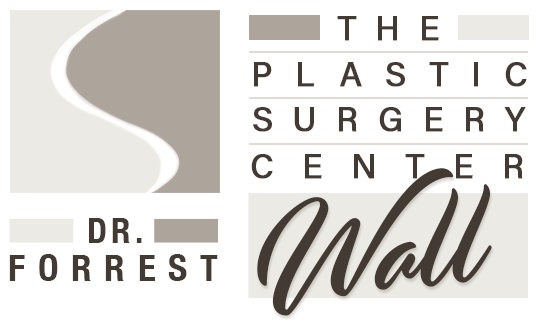
Many women report much higher levels of self-confidence and happiness following a breast augmentation, whether it be from an A cup to B cup, an A cup to C cup, or a B to D cup. Whatever the increase in cup size, this procedure is ideal for women that have lost breast volume or lift due to weight loss or pregnancy as well as women that have always had smaller breasts. Our team of experts at The Plastic Surgery Center in Shreveport understand that breast augmentation can be a big step. We offer consultations with our board-certified plastic surgeon so you can be ready to make the best decision to meet your goals for a Shreveport breast augmentation surgery.
What is the Typical Recovery Time for a B to D Breast Augmentation?
Breast augmentation surgery recovery lasts an average of 6 weeks, with many women reporting they feel perfectly fine after one week. After your breast augmentation, you will feel sleepy and sore and will need someone to drive you home. You’ll have gauze wrapped around your breasts, and Dr. Wall may prescribe medication for pain or antibiotics to prevent infection. After the first week, many patients experience a decrease in swelling and discomfort and are able to return to light activities. To ensure the best results, it’s important to let Dr. Wall test your recovery and clear you for more strenuous activities.
Will I Lose Sensitivity in My Nipples After Breast Augmentation?
Changes in nipple sensation may vary in the days after breast augmentation surgery. The good news is that most patients regain nipple sensation within weeks or months of their procedure. The augmentation type, incision, placement, and size all factor into nipple sensitivity. Choosing breast implants that are too large for your body may strain the nerves leading into the breast and affect your nipple sensation. Breast augmentation from a B to a D cup might be a smart choice for this reason. We’ll talk with you about these possibilities and help you weigh your options during your consultation.
How Long Do Breast Implants Last?
Women come to Dr. Wall for breast augmentation because they want results that look natural and elegant but also last. Breast implants don’t technically expire, but they’re still not guaranteed to last a lifetime. The average saline or silicone implants may last anywhere from 10 to 20 years. Today’s implants are more durable and sophisticated than the ones of the past because of years of rigorous research and testing.
The most common reasons for breast implant removal or replacement are
- Ruptures. Breast implant ruptures are rare in the first few years but may happen over time with both saline and silicone implants. Both silicone and saline implants contain an outer shell made of a strong form of silicone. Although made to withstand extreme pressure and heat, the outer shell can sometimes break or become punctured. Dr. Wall will talk with you about how to detect a ruptured implant.
- Hardened scar tissue. Some women may experience hardened scar tissue around one or both implants. This might cause tightness, pain, tenderness, and abnormal cosmetic changes to the breast.
- Change in position. As you continue to grow older, gravity and changes in your skin and breast tissue will likely cause your breasts to look different. For some women, this means drooping or sagging; for others, it means splaying or tissue migration.
In your consultation, Dr. Wall will recommend what type of breast augmentation is best for you and might have the best longevity.
Will I Still be Able to Breastfeed?
Most women with breast implants are able to breastfeed, though there are a few exceptions. The type of incision used and the original state of your breasts will determine your ability to breastfeed. It is most common to place implants behind the milk glands or under the chest muscles, which don’t affect milk production. Incisions made under the breast or through the armpit or belly button are less likely to interfere with breastfeeding. Surgery that keeps the areola intact is less likely to cause problems. An augmentation of a B to D cup is less drastic and may lead to better breastfeeding outcomes. Discuss any concerns you have about breastfeeding with Dr. Wall so he can recommend the best type of procedure for you.
We Provide More Information on Breastfeeding After an Augmentation Here.
What are Potential Complications From Breast Augmentation B to D?
Many clients experience few or no complications from breast augmentation. However, all surgeries present possible risks. An unqualified cosmetic surgeon might cause more tissue and nerve damage. Choosing a board-certified plastic surgeon such as Dr. Wall is key to reducing your risk of complications.
Some of the most common complications are:
- Infection
- Breast pain
- Scarring
- Bleeding
- Changes in the sensation of the nipple
- Problems with the size or shape of the implants (i.e. the breasts may not be even)
In your consultation, Dr. Wall will learn about your general health to evaluate your risk of complications.
How Should I Prepare for My Breast Augmentation?
Dr. Wall will discuss medically necessary steps to take before your surgery. These might include not smoking, adjusting your medications, and avoiding food before surgery. There are some non-medical things you can do to make your transition home a bit easier:
- Prepare your space. Keep your necessities in one place so it’ll be easier to find them when needed. Set up comfortable areas in your living room where you can rest during the first few weeks after surgery.
- Prepare your wardrobe. While recovering from surgery, it is recommended that you wear comfortable, loose-fitting clothing. You’ll want to avoid underwire bras for at least a week, opting for soft sports bras instead.
- Child and pet care. After surgery, running after or picking up toddlers or pets could compromise your recovery. Try to enlist the help of a family member or a caretaker for anyone who might need your help.
- Buy supplies ahead of time. Make sure to fill any prescriptions Dr. Wall prescribes you before your surgery. You might also want to buy ice packs, drinking straws, and body cleansing wipes to use until you can safely shower.
- Plan your return to activities according to Dr. Wall’s recommendations. Depending on the intensity of your job, you might want to plan to take off anywhere from a week to one month of work.
The Plastic Surgery Center will be with you at every step of your journey to answer any questions you have about your recovery. Our clients can tell you how happy they are with their results and care. If you’re interested in a breast augmentation for a B to D cup increase or any other type of breast augmentation, contact us today! You can reach us by filling out our online intake form or by giving us a call at 318-221-1629.
